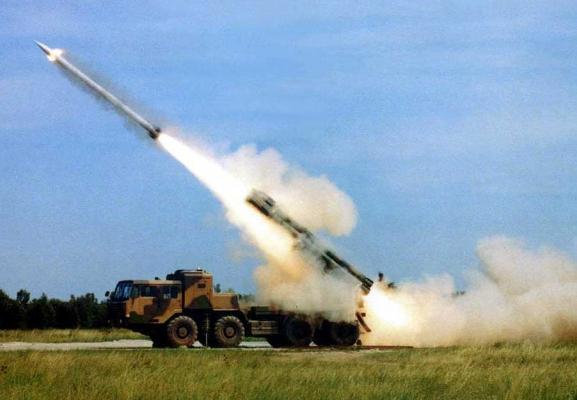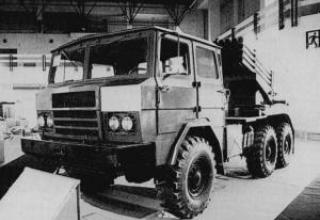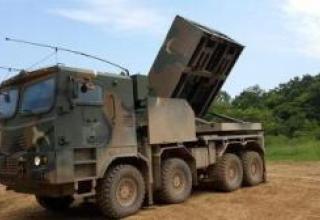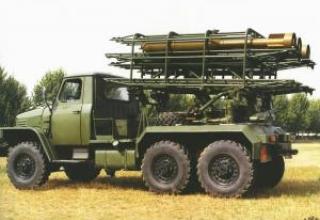The A-100 multiple rocket launcher system is designed to deliver accurate strikes and engage enemy groups and ground targets such as large armored units, military bases, missile launch positions, airports, harbors and other important objects.
The A-100 mLRS was developed by the China Academy of Launch Vehicle Technology (CALT) on the basis of the Russian 9K58 "Smerch" mLRS, several copies of which were received by China in 1997. It was announced that the development was completed in January 2000. Production of A-100 is deployed at the enterprises of China National Precision Machinery Import and Export Corporation (CPMIEC). The system entered the service of the Chinese People's Army in 2002 in the 1st Artillery Division of Guangzhou Military District.
The system is being actively improved to improve its range and accuracy, develop new types of combat equipment, and deploy on various carriers, including in the interests of the Chinese Navy (see photo). According to the developers, the maximum range of fire is 100km (according to other data, about 85km). It is reported that the development of new 300-mm retractable projectiles with a range of 70 to 180 km has begun. These projectiles can be used in the A-100 system without any modifications.
At present, the A-100 system is offered for export. As of 2006, 39 combat vehicles have been assembled.
Composition:
Composition of the RESO:
- combat vehicle (BM);
- corrective 300-mm rockets;
- transport and charging machine (TZM);
- command and staff machine;
- arsenal and training equipment.
The layout of the combat vehicle (see photo) is generally similar to the Russian 12-barrel 9A52 and 9A52-2 9K58 "Smerch". The artillery unit of the A-100 MRMA is a package of 10 tubular smooth wall guides fitted with a screwed U-slot. The artillery part is mounted on the modified chassis of the cross-country vehicle WS-2400 with the wheel arrangement 8x8, payload - 22 tons. Maximum travel speed is 60 km/h. The range of travel is 650 km. Maximum overrun is 37%, depth of ford is 1.1m.
The combat vehicle is equipped with an automated fire control system, on-board control and communication equipment, which provides:
- Automated high-speed reception (transmission) of information and protection against unauthorized access;
- top linking, navigation and orientation of the PM in the field, including the use of GPS system;
- pointing a package of guides without leaving the cabin.
- automatic measurement of surface meteorological data and preparation of data for firing.
Information on targets is transmitted to the combat vehicle from the battery's fire control system (FCC). Information input and prelaunch checks of all 10 missiles take about 90 seconds, full salvo time - 60 seconds. The guidance package is guided from the cockpit of the BM, where the control equipment is located. Guidance drives are hydraulic with manual doublers. In the combat position, the fighting vehicle is supported by four jacks, which are driven by the hydraulic system. The first pair is located between the first and second axles, and the second - between the third and fourth. The time to prepare for firing is 6 minutes, and the time to urgently leave the combat position after the volley is 3 minutes. The PM is recharged in the technical position using the TZM.
The battery DMA is mounted on a modified truck chassis with 6*6 wheel arrangement and is equipped with a data transmission system, radio communication, computer system and satellite navigation system. It is provided with meteorological data measurement and reception, trajectory calculation and automated data transmission for firing to the battery combat vehicles.
TZM is made on the same vehicle chassis, which is used in combat vehicles, and is equipped with a built-in elevator, which provides fast automatic recharging. The recharging time is 15-20 minutes.
Corrected rockets (cattle) of 300 mm caliber with minimum range of 40 km and maximum range of 100 km are used for firing. The length is 7276 mm, weight - 840 kg, weight of BC - 235 kg. Heap at maximum range - < 1/290 (1/300). Permissible height of application above sea level - 3000 m, ambient temperature - from -40 to +55 ° C, shelf life of shells - 10 years. Several types of head units, including cassette ones, have been developed for the projectile. The cassette warhead can be equipped with 500 cumulative shrapnel-type warheads (CSBEs) or 5 self- aiming warheads (SEAMs). SSBEs are designed to engage manpower and light armoured vehicles with a kill radius of 7m and the armour penetration of 50mm of homogeneous armour. SPCE have an armor penetration up to 70mm homogeneous armor at an angle of 30 ° from normal.
The cattle consists of an electronic time device, a control system unit, a head unit, a single-chamber solid rocket engine and a tail compartment with a stabilizer unit. RDTT charge is made of mixed fuel with a binder based on polybutadiene copolymer with hydroxyl end groups (HTPB). Stabilization of the projectile in flight is achieved by rotating it around its longitudinal axis, which is provided by pre-twisting during twisting on the tube guide and supported in flight by installing the blades of the expanding stabilizer at an angle to the longitudinal axis of the projectile. The cattle control system during the first three seconds of flight determines the deviation between the current position of the projectile and the calculated trajectory and transmits the data to the trajectory correction system. The correction is performed by gas-dynamic rudders driven by high-pressure gas from the onboard gas generator. The control system also determines the time of the cassette HF detonation, which ensures the breeding of submunitions with the necessary accuracy.
The A-100 RSF battery includes the battery command post, 6-9 BM and 6-9 TZM.
Characteristics:
| Range of fire, km | 40-100 (85) |
| The length of the projectile, mm | 7276 |
| Caliber,mm | 300 |
| Weight, kg | 840 |
| Cassette Weight BC, kg | 235 |
Testing:
In the mid-1960s, in order to study the impact of aggressive propellant components on the missile during its long-term operation, on the initiative of V.N.Chelomey at the test base in Faustovo were built two mine launchers for missiles 8K84. One of the silos was manufactured in the standard version and was intended for research of the standard missile during the entire warranty period of its storage. This mine also contained more than 1000 samples of materials - metals, non-metals, rubber goods, adhesive and welded joints of various shapes and combinations, radio equipment, pumps, batteries and much more. In addition to the employees of OKB-52 more than 100 related enterprises participated in the research of materials resistance to long-term storage. Simultaneously, several times a day for the duration of many years of storage about 100 parameters (temperature, humidity, gas content, pressure in tanks, etc.) were registered. The second mine was also designed for the 8K84 missile. The rocket installed in it was filled with aggressive components and stored at a temperature of + 50 degrees for accelerated corrosion tests within one year. During the experiments, no serious malfunctions or failures of rocket systems were detected in any of the mines. The results of these tests extended the warranty period for subsequent modifications to 15 years, then to 20 years, then to 25 years.
Sources:
- A-100 300mm multiple launch rocket(http://www.sinodefence.com)
- Гуров С.В. "Реактивные системы залпового огня" .-Тула.: "Пересвет", 2006-С.263-264.












